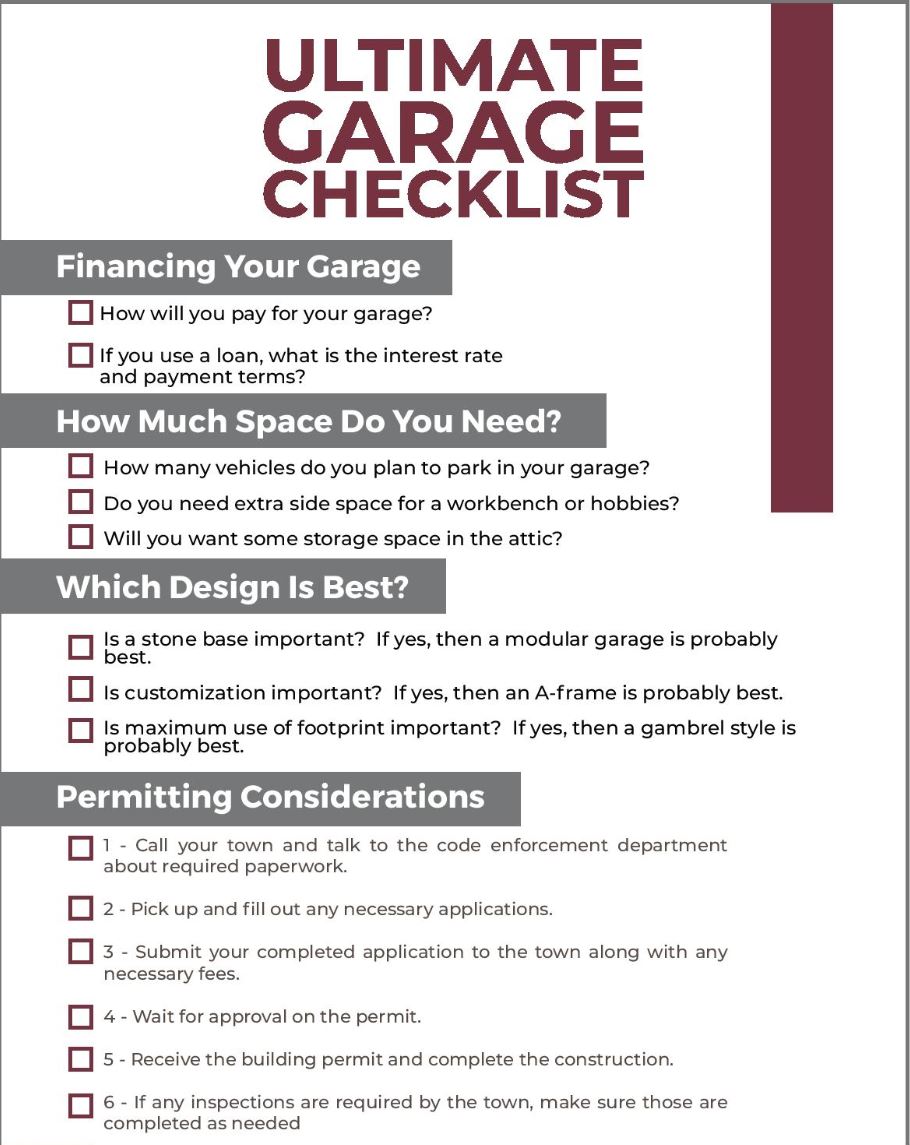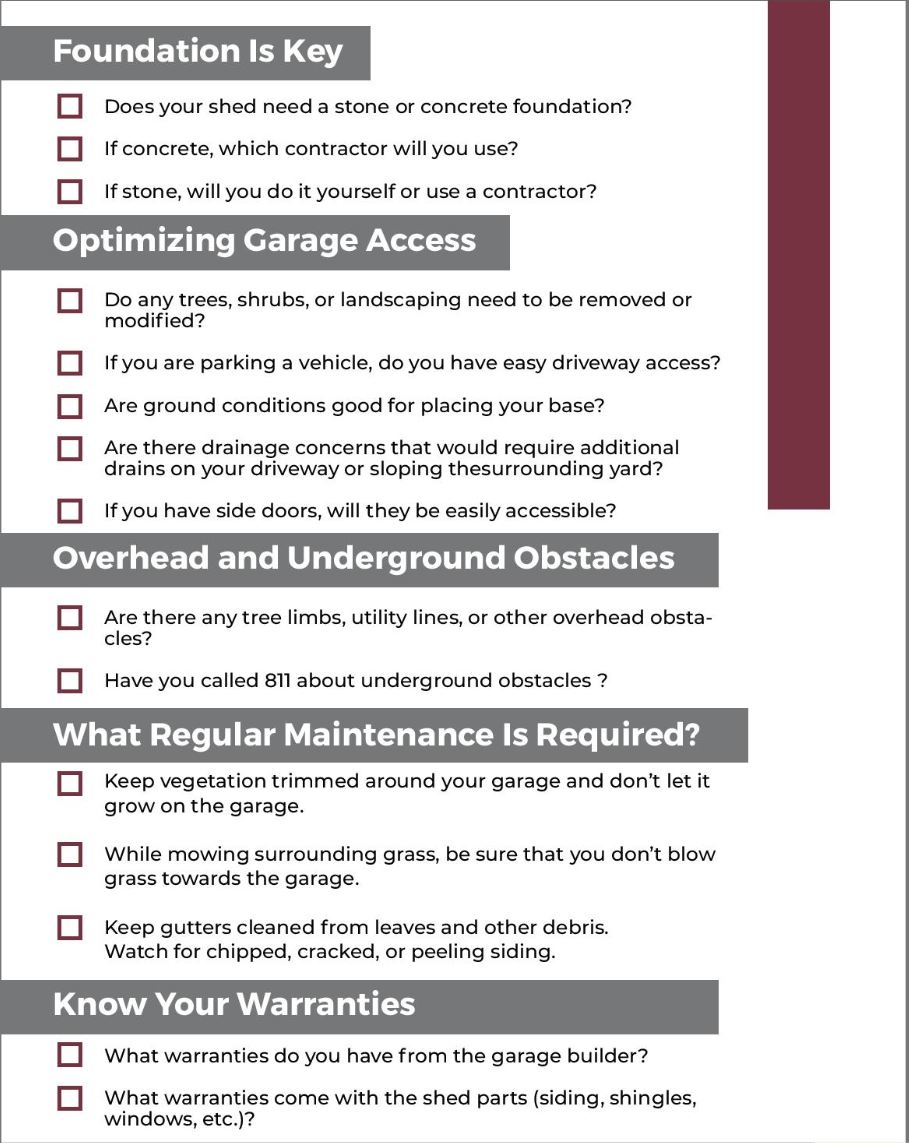The Ultimate Guide in Preparing for a Prefab Garage
Congratulations, you are ready to take the next step in purchasing your own garage!
There is a lot of excitement as you think about moving forward with your garage. After all, who isn’t excited when they think about increased storage, a new home for their car or truck, and more room to focus on your hobbies and outdoor activities?
But you may also be feeling some uncertainty in making sure you choose the right garage, having your property ready for it, and being able to enjoy it to the max.
If this uncertainty describes you, then you are in the right place!
This guidebook will walk you through everything you should be considering when you purchase your garage. In the end, you can find all this information in a condensed checklist as well.
Ready? Let’s get started!
Table of Contents
How Much Garage Space Do You Need?
No one wants to purchase a new garage only to discover that it is not large enough for their needs!
In fact, roughly 1 in 4 Americans with a garage has it so cluttered that they cannot fit a vehicle in the garage bay!

When working through the design and proposal process, here are a few things that you will want to consider:
1 - Vehicle storage: How many vehicles do you plan to store in the garage?
This may seem too obvious at first! After all, if you have 2 cars, then you want 2 garage bays, right?
Another thing to consider is riding equipment other than vehicles. This can include mowers, golf carts, ATV’s, or other yard and riding equipment.
But sadly, many people do purchase garages without really thinking about how many vehicles they want to store in the building.
2 - Room for hobbies: How much room do you want beside your vehicle bays?
When many people picture a garage, they think of a large workbench with plenty of room for tools on tool boxes and the wall.
If a workbench, or some other hobby that you have, is something that you want room for in your garage, then you need to consider this space during the design process.
What happens if you don’t plan this additional space?
Imagine if you plan to park your car in the garage, but you don’t add space for a workbench. Suddenly you find your tools getting dangerously close to your car and almost no space to walk or do actual work!
If you want to learn more about optimizing a prefab garage, especially with a loft, read our article on prefab 2 car garages with a loft.
3 - Storage space: Do you need extra side or attic space?
Although this is similar to the question about hobbies, storage space is a great way to utilize your garage attic or other small areas.
4 - So how much space do you need?
For average cars, minivans, and SUVs; follow these guidelines:
- 1 car: 12-14 feet wide
- 2 cars: 24-26 feet wide
- 3 cars: 36-38 feet wide
If you plan to park a pickup or larger vehicle in the garage, then you want to add 2 extra feet per bay.
These measurements will allow a standard vehicle adequate space to park, open doors, etc., but they don’t allow for many extras.

For storage space beyond garage bays, follow these guidelines:
- For bikes, hand tools, boxes, etc, plan an additional 4-5 feet
- For larger equipment like riding mowers or ATVs, take the width of your largest piece of equipment and add 2 feet
- If you want room for an active workspace, a minimum of 10 feet is suggested
Talk with your builder about your goals for your garage during the design process. They will be able to help you fine-tune your space considerations and final garage dimensions.
Which Prefab Garage Design Is Best?
With the full range of designs, material options, and storage configurations; it can be challenging to decide which garage style will work the best for your consideration and budget.
While many designs are available, we are going to look at 3 of the most basic models. Each of these designs can be modified to work with specific requests that you might have.
Also, if you are getting your garage specifically for storage, then check out our blog post on maximizing prefab garage storage as well!
The A-Frame Garage
A-frame garages are the “jack-of-all-trades” when it comes to garage design. They use either a truss or rafter style to make it one of the most recognizable and popular garage styles.
Because of their roof structure, a-frame garages can be customized in almost every way: 2nd floor and attic space options, multiple garage bays, additional doors and entryways, side storage, etc.
A-frames will cost more, especially if you choose a larger model or go with multiple levels of customization. They also require a concrete base as the foundation.
If you are looking for customized options that are more than just storage, the A-frame is an excellent option.
Pros - Customizable, can include an attic, plenty of storage options.
Cons - Has a larger footprint, needs a concrete base.
The Modular Garage
The modular garage is the most basic line of garages. They offer a basic design without some of the frills and unique design options that other garage styles offer.
However, this basic nature also means that they are one of the most affordable garage types. They are also one of the few garage types that allow a crushed stone base instead of concrete.
If you are looking for primary storage for 1-2 cars and storage, the modular garage is a great option.
Pros - Most affordable option, can use crushed stone as a base, can be quickly set up.
Cons - Very basic garage with minimal customization, not as much side space if used for vehicle storage.
The Gambrel Garage
The gambrel style is a unique style due to the rafter structure, but it focuses on maximizing the most storage out of any given footprint.
The rafters are designed to maximize the available space in the attic. This allows the maximum amount of storage, office space, or even living space available without using too much real estate.
If you are looking to optimize the 2nd floor of your garage with the best use of the footprint, the gambrel garage is one of the best options.
Pros - Maximize attic space, customizable, most efficient use of garage footprint
Cons - More expensive, usually need a concrete base.

Garage Permitting Considerations
Before you go too far in purchasing your new garage, you want to make sure that you have everything approved by your local township, village, or city.
Because you are putting a structure into place, many towns require a garage to have a permit. There may also be setbacks or other requirements even if a building permit is not required.
The last thing you want is a fine or requirement to remove your garage, especially if you have paid for it!
But don’t worry, here are some simple steps that will make your new garage ready to go.

1 - Call your town and talk to the code enforcement department. This department manages the permitting.
2 - Pick up and fill out any necessary applications. You may need some plans or blueprints, and the builder should be able to provide these documents.
3 - Submit your completed application to the town along with any necessary fees.
4 - Wait for approval on the permit. If the garage is placed before a permit is issued, the town does have the right to issue a fine or other penalties.
5 - Receive the building permit and complete the construction.
6 - If any inspections are required by the town, make sure those are completed as needed.
Remember, permitting does not have to be scary if you follow these steps and follow the blueprints!

Foundation Is Key For Prefab Garages
In any structure, the foundation is essential, and garages are no different.
Most garages will require a concrete foundation due to their size and weight, but some modular garages can be placed on a stone base.
If you are unsure which base to use, check with your builder to confirm you are creating the right foundation.

If a concrete foundation is required, your best option is to have a contractor prepare and pour the base for you. Because you cannot modify concrete after it sets, it is crucial that the job is done correctly.
With a stone base, however, you may be wanting to put the base in yourself.
If that describes you, then here are some instructions on having the proper base before your garage arrives:
- Determine the highest point of the slope and use this for the top of the pad. This avoids the base being in a bowl.
- Over-extend the base an extra 1’ in every direction.
- Use pressure treated lumber for the border; typically 4x4 or 4x6 boards work well.
- Make sure the perimeter is square.
- Use 3/4 “ clean stone for the base.
- Plan for 4-6” thick stone base after compaction.
- Make sure the final base is level before the garage is placed.
- Backfill any exposed areas outside the base with dirt and compact it.
Financing Your Prefab Garage
Before you go too far, you need to know how you plan to finance your new garage. After all, nothing in this world is free, is it?
Sadly, some people don’t think about the financial side until they have either signed the dotted line or let their dreams go wild. Going too far without looking at the finances can result in hurt credit, harmful debt, or crushed dreams.
So what options are available for financing your garage?
1 - Cash purchase
This option is the most straight forward option. If you have received an estimate on a garage, you simply see if you have enough cash to pay for it.
Often a cash purchase will be spread out over several payments. There may be a down payment, a fee to begin construction, and a final payment. The payment structure will ultimately depend on your builder.
So what are the pros and cons of a cash purchase?
The biggest positive is that you own the garage outright. Therefore, you don’t pay any interest or payments, and there is no concern on the garage being repossessed.
A negative with a cash purchase is that you need to have the money upfront and in a form that can be quickly paid to the builder.
2 - Personal loan or HELOC
Personal loans come in many shapes and sizes. It might be a line of credit from a local bank, a loan from your 401k or investment account, using a friend or family member’s money, or a HELOC (home equity line of credit).
If you have access to these options, it may be challenging to choose which loan option is the best. Here are a few things to consider:
- What is the interest rate on the loan?
- What is the term of the loan? Longer terms usually have lower payments but result in paying more interest.
- What happens if you can’t pay your loan?
What are some pros and cons of a loan?
The biggest pro is that you don’t need to come up with all the money upfront like a cash purchase. Instead, you use the loan to purchase the garage, and then you pay back the loan in regular payments.
One of the biggest concerns with a loan is that you will be paying interest on it. This will result in you paying more for the garage than expected because of the interest portions that you make.
3 - Rent-to-own
Rent-to-own agreements are usually made directly between the buyer and the garage builder, or a finance agency that the builder works directly with.
Rent-to-own purchases can look attractive because it usually requires a minimal down payment and can be easy to qualify, even if your credit score is low.
However, these options often come with higher interest rates and more fine print, including the builder usually having the right to repossess your garage if you do not make the payments.
So what is the most significant negative and positive of rent-to-own?
A positive is that it is usually easy to get a rent-to-own agreement. It requires little money down, a low credit score, and often little paperwork with fast approval.
The biggest negative is two-fold: Interest rates are often higher than personal loans, and the agreements usually allow your garage to be repossessed faster than a personal loan.

Optimizing Modular Garage Access
During the planning stages of your garage, you want to think about how to maximize the garage’s footprint and storage.
Why is this an important part of the process?
The first or most obvious place for a garage may not always be the best. Because your garage will be a permanent structure and you will have a stone or concrete base, you need to think carefully about how it will actually fit into your yard or driveway.

Here are some questions to think about in optimizing access:
- Do any trees, shrubs, or landscaping need to be removed or modified?
- If you are parking a vehicle, do you have easy driveway access?
- Are ground conditions good for placing your base?
- Are there drainage concerns that would require additional drains on your driveway or sloping the surrounding yard?
- If you have side doors, will they be easily accessible?
Thinking through these questions and laying out the garage footprint in your yard will help you avoid any nasty surprises after your garage is placed.
After all, no one wants to learn that they can’t fully use the features of their brand new garage!
Overhead & Underground Obstacles
One of the things that sometimes is missed in getting a garage is the possibility of overhead and underground obstacles.
One of the worst feelings in construction is hitting a wire, pipe, or vent while digging or operating a crane. The damages caused by these mistakes can be dangerous and are often expensive.

So what can you do to plan better?
Overhead Obstacles
Overhead obstacles are pretty obvious because you can see them. Look for tree limbs, utility lines, or other obstacles that are in the way.
For example, if you have a concrete truck coming in to pour the base, will it be able to reach the pad without hitting any overhead or side obstacles?
Underground Obstacles
Underground obstacles are usually harder to find because you cannot see them. They can consist of underground electrical lines, water pipes, sewer pipes, septic leach fields, gas pipes, cable or phone lines, etc.
The best first step in checking for underground obstacles is dialing 811.
The 811 call center reps will assist you in having your local utilities come out and mark out everything that goes underground.
What Regular Maintenance is Required for a Modular Garage?
Like any building, garages will take some regular maintenance.
The good news is that if you are getting a new garage, the maintenance required will be minimal for many years.
However, to get the most life out of your garage, here is some regular maintenance that should be performed on your garage:
- Keep vegetation trimmed around your garage and don’t let it grow on the garage.
- While mowing surrounding grass, be sure that you don’t blow grass towards the garage.
- Keep gutters cleaned from leaves and other debris.
- Watch for chipped, cracked, or peeling siding.
Know Your Warranties
You should have warranty information for all the different parts of the garage project.
The most important part of the warranty is the actual garage itself. Depending on your builder, they may offer a standard warranty that covers any workmanship issues on the garage.
Another important warranty information is the parts of the garage. This is usually the roof, siding, windows, and other major components of the garage.

If you had a contractor build the garage base, you might also have a warranty for any work that was done for the base. This is good to know if you have issues with concrete cracking, the base not being level, etc.
Hopefully, you will not need to use this warranty information, but mistakes do happen, and if you have your warranty information ready you can save substantial money for parts and labor that are still under warranty.
Conclusion
Having a garage is a huge asset in increasing your storage, protecting your vehicles, and giving you more room for hobbies and living life.
However, it is also something that needs careful planning before the garage is actually delivered.
Going through these nine steps will help you be fully ready when your garage is delivered. To make it easier to follow the steps, feel free to use the checklist below.
We wish you the best as you enjoy your new garage!
If you are looking for an Amish built prefab garage, then contact us at Pequea to discuss your ideal custom garage!













